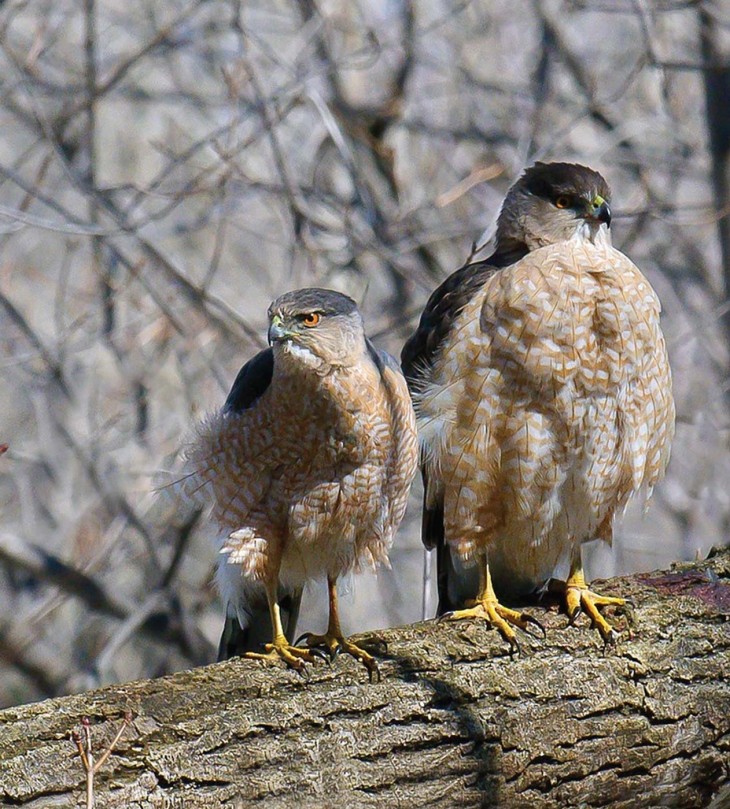
Although the largest vertebrate that has ever lived is the female blue whale, in most species of birds and mammals, males are larger than their mates. In birds of prey (hawks, falcons, eagles, and owls), however, this pattern is reversed: females tend to dwarf males. For more than a century, biologists have attempted to explain this “reversed size dimorphism” (RSD) in raptors by studying the behavior patterns, sex role differences, and ecology of these birds. They have developed several possible explanations, from courtship safety and nest protection to brooding benefits and advantages for hunting.
One of these is that bigger females are safer. In many bird species, males offer potential mates food morsels during courtship; in birds of prey, sharp bills and talons make this courtship ritual a potentially dangerous affair. This argument suggests that females that consistently choose smaller mates are better protected and therefore survive to produce more offspring. (It doesn’t, however, explain why the sharp talons of heavier females do not harm smaller males.)
A large-size female can also be a formidable nest defender. The nest defense hypothesis suggests that the larger female can more successfully protect eggs and young from predators than the smaller male. For example, female northern goshawks are known for their fierce nest protection: attacking photographers, knocking over bicyclists, and leaving joggers with bloodied heads. In 2020, Australian ornithologist Jonny Schoenjahn led a study suggesting that because predation is a major cause of nest failure, having a larger female at the nest would more effectively protect young and thereby pass on genes to the next generation. Schoenjahn pointed out that this logic can be applied to all birds of prey: If the female is the primary nest defender, then she is larger than the male.
Another possible explanation for RSD involves the reproductive advantages of larger females, which may produce more eggs per clutch and accumulate greater stores of fat and protein to sustain them through incubation and brooding. During this period, the female withdraws from the risk associated with hunting, often remaining motionless on the nest for long periods. Meanwhile, the male hunts for his mate, chicks, and himself. But why should this make him smaller than his mate?
The answer may lie within the “niche hypothesis,” which describes the role of an organism within the ecosystem, including its interactions with other species and its environment. Here is where the size and agility of prey taken by the male and female hawk become important. The late Tom Cade, Cornell ornithology professor renowned for his effort to conserve peregrine falcons, offered this theory: For bird-eating hawks, smaller bird species are more abundant prey than larger bird species; smaller birds, however, are more agile and thus more difficult to capture than larger birds. So, it would be advantageous for male hawks to match as closely as possible the body size of the prey species, thereby matching prey agility during the chase. As it turns out, the faster and more agile the prey species, the greater the male-female size difference of the raptor that feeds on it.
Thus, male-female size differences are greatest in bird-eating raptors, then decrease progressively in those that feed on mammals, fish, slow-moving invertebrates, and down to carrion. While there’s little size difference between male and female vultures, which are scavengers, for example, in northern goshawks and peregrine falcons (both bird-eaters), males are only about 64 percent of the weight of the female. Male red-tailed hawks, which primarily prey on mammals, are about 84 percent of the weight of the female.
The sharp-shinned hawk, our smallest North American hawk, also shows a large male-female size difference with males just 57 percent of the weight of the female. I once watched a male sharp-shinned chase a chickadee around and around a small hemlock. As it coursed back and forth, the hawk’s wings sounded like a rope being whipped around overhead. (Try this rope sound to get chickens to go to their coop.) I have also seen a female sharp-shinned hawk take down a mourning dove, pluck it, then begin feeding. The niche hypothesis suggests that this large male-female size difference would reduce competition between mates by partitioning food sources, allowing each to feed on different size prey species.
Additional niche components, including hunting habitat complexity and territory size, may also influence RSD. Using data on a wide range of diurnal raptors, Lorenzo Pérez-Camacho and his colleagues at the Forest Ecology and Restoration Group, Universidad de Alcalá, Spain, found a correlation between the structural complexity of a raptor’s hunting habitat and RSD. The more complex the hunting habitat – from the low complexity of open fields to the high complexity of forest interiors – the greater RSD. The researchers also found that RSD is greater with an increase in nesting territory size. In their 2018 article published in the Journal of Avian Biology, the authors conclude that their findings, together with the different prey sizes used by male and female raptors, help explain the evolution of RSD.
These are some of the more compelling explanations used to unravel the mystery of RSD in birds of prey, but scientists are still not certain why this size difference exists. It’s a fun question to ponder as you look to the trees and the sky to see what raptors – male or female – you might find.

